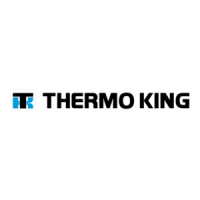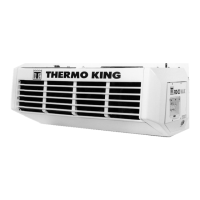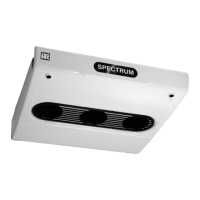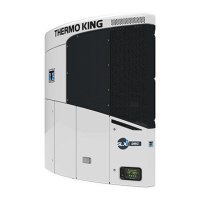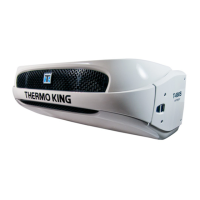Do you have a question about the Thermo King RD-II SR 30 and is the answer not in the manual?
Overview of the RD-II SR's features and design for transport temperature control.
Components of the microprocessor-based control system managing unit functions.
Description and location of the switch that powers the microprocessor.
Details the electric standby option for Model 50 units.
Lists safety devices and fuses that protect the unit's operation.
Procedures for operating the unit, including pre-trip checks.
Procedure for performing a complete unit checkout before loading.
Guidelines for selecting CYCLE-SENTRY or Continuous Run modes.
Technical details of the TK 3.95 engine, including oil, rpm, and pressure.
Specifications for adjusting belt tension on various components.
Specifications for the R-134a system, including charge and settings.
Specifications for the R-404A system, including charge and settings.
Specifications for the Hilliard engine clutch engagement and torque.
Details of the unit's electrical control system components and voltage.
Data on current draw and resistance for various electrical components.
Specifications for electric motors and heaters in Model 50 standby.
Requirements for supply circuit breakers and extension cords.
Setting specification for the air switch.
Description of the touch-sensitive keys on the remote panel.
Explanation of the remote control panel's display segments and icons.
Procedure for starting the unit's engine via the remote control panel.
How to manually start a defrost cycle using the remote panel.
Procedure to display the unit's software revision number.
How to navigate and view different operational screens on the display.
Steps to view and clear alarm codes displayed on the remote panel.
Details on alarm types, codes, and how alarms are indicated on the µP-T system.
Guide to performing the unit's self-check for operational capability.
Essential safety guidelines for handling the unit and its components.
Warning about the unit's automatic start/stop functionality and precautions.
Information on environmental impact and safe handling of refrigerants.
General first aid procedures for exposure to refrigerants and oils.
Specific first aid instructions for contact with refrigeration oil.
Precautions and first aid for high and low voltage electrical systems.
Safety considerations for low voltage circuits and potential burn hazards.
Precautions for servicing units with µP-T microprocessors, including ESD.
General precautions before performing electrical maintenance.
Notes on compatibility and replacement of alternators with integral regulators.
Step-by-step guide to diagnose charging system issues before component replacement.
Troubleshooting high voltage output from the charging system.
Inspection and maintenance of the unit's battery.
Inspection of unit wiring and harnesses for damage or wear.
Inspection of relay contacts for pitting or corrosion.
Procedure for checking the 12 VDC charging system after start-up.
Function of the preheat buzzer module.
Description and function of the RPM sensor.
Procedure for testing the RPM sensor's AC voltage output.
Information on glow plug function and testing for defects.
Checking fan rotation during electric standby operation.
Procedure for testing and adjusting the defrost air switch.
Calibration procedure for the air switch.
Explanation of the TherMax™ heating system's function and operation.
Details the engine's pressure lubrication system and oil specifications.
Procedure for replacing the engine oil filter.
Function and inspection of the crankcase breather system.
Maintenance procedures for oil bath and dry type air cleaners.
Description of the closed, circulating cooling system and its components.
Method for checking antifreeze concentration and type.
Step-by-step procedure for draining and refilling the engine coolant.
Guidelines for periodic inspection and replacement of antifreeze.
Procedure for purging air from the cooling system after filling.
Recommended thermostat for optimal engine operation.
Overview of the high-pressure fuel system and its components.
Procedure for removing air from the fuel system after running out of fuel or repairs.
Consequences of water in fuel and periodic draining recommendations.
Steps for removing and installing the fuel filter.
Operation, maintenance, and troubleshooting of the electric fuel pump.
Procedures for adjusting engine speed and injection pump timing.
Detailed steps for timing the injection pump to the engine.
Procedure for checking individual cylinder timing when the engine runs poorly.
Instructions for adjusting valve clearance to proper engine operation.
Information on the fuel limit screw and CARB regulations.
Description of the engine mounting system components.
Exploded view and parts list for the idler assembly.
Cautionary notes regarding the unit's automatic start/stop feature.
Procedures for setting belt tensions on various drive components.
Instructions for adjusting belt tension on multiple fan and belt configurations.
Location and function of the integral fuel stop solenoid.
Overview of the TK 3.95 engine operation and fuel solenoid control.
Procedures for adjusting low and high engine speeds.
Description of the evacuation station and its components.
Explanation of why system evacuation is crucial for performance and longevity.
Procedure for setting up and testing evacuation equipment for leaks and performance.
Method for identifying and locating leaks in the refrigeration system.
Indication of system moisture and the need for additional dehydration.
Step-by-step guide to evacuating the refrigeration unit to a low micron level.
Procedure for charging the refrigeration system with refrigerant.
Steps for safely removing evacuation hoses after charging.
Methods for detecting refrigerant leaks in the system.
Procedures for testing the refrigerant charge level in both empty and loaded boxes.
Procedure for checking compressor oil level under various ambient temperatures.
Description and testing of the high pressure cutout switch.
Procedure for pumping down the compressor and checking system pressure.
Description of the three-way valve's bypass check valve function.
Procedures for removing and installing the accumulator.
Procedures for removing and installing the compressor.
Procedures for removing and installing the condenser/radiator coil.
Procedures for replacing the liquid line check valve.
Procedures for removing and installing the dehydrator (filter-drier).
Procedures for removing and installing the evaporator coil.
Procedures for removing and installing the expansion valve assembly.
Procedures for removing and installing the heat exchanger.
Procedures for removing and installing the high pressure cutout switch.
Procedures for removing and installing the high pressure relief valve.
Procedures for removing and installing the pilot solenoid.
Procedures for removing and installing the pressure regulator valve.
Procedures for removing and installing the receiver tank.
Procedure for repairing the three-way valve's bypass check valve.
Procedure for repairing the three-way valve.
Information on refrigerants R-134a and R-404A used in the industry.
Methods for identifying units charged with R-134a and R-404A.
Information on the availability of refrigerants R-134a and R-404A.
Recommended equipment and precautions for using R-134a and R-404A.
Procedures for cleaning equipment to prevent refrigerant contamination.
Information on adapting systems for R-134a and R-404A refrigerant recovery.
Maintenance schedule for the bypass oil filter on X426 compressors.
Description of Thermo King's refrigerant recovery system.
Procedures for removing, repairing, and installing the throttling valve.
Inspection and maintenance schedule for the clutch assembly.
List of tools needed for clutch maintenance.
Specification for the grease used in clutch assembly.
Steps for disassembling the clutch assembly.
Procedure for removing the clutch housing.
Procedure for removing bearings from the clutch hub.
Procedure for reassembling the clutch assembly.
Procedure for installing bearing races into the clutch hub.
Procedure for periodically checking and tightening unit and engine mounting bolts.
Guidelines for inspecting the unit for loose wires, leaks, or damage.
Procedure for cleaning the evaporator coil.
Procedure for cleaning the condenser coil.
Instructions for positioning the fan and hub assembly for optimal performance.
Checking and adjusting the defrost damper for proper air flow control.
Procedures for disassembling and reassembling the jackshaft assembly.
Overview of the fanshaft assembly and checks for oil leakage.
Detailed steps for disassembling and overhauling the fanshaft assembly.
Procedure for installing a new oil seal in the retainer cap.
Information on shims and O-rings for the shaft assembly.
Procedure for torquing retainer plate bolts.
Procedure for checking and adjusting shaft end play.
Description of the fan shaft assembly components and lubrication.
Procedure for installing the idler pulley seal assembly.
Troubleshooting when the unit switch is ON but nothing occurs.
Diagnosing issues when indicators are on but the engine won't crank.
Troubleshooting steps when the engine cranks but fails to start.
Possible causes and remedies when the engine stops after starting.
Diagnosing low engine power issues, including fuel and air restrictions.
Troubleshooting excessive smoke due to rich fuel-air mixture.
Diagnosing engine knocking sounds and their causes.
Troubleshooting for an overheating engine.
Diagnosing issues with low or suddenly dropping oil pressure.
Identifying and addressing causes of high oil consumption.
Troubleshooting blue smoke, indicating oil consumption.
Diagnosing white smoke, indicating unburnt fuel.
Troubleshooting battery recharging issues in the electric standby system.
Troubleshooting when unit indicators do not light up.
Diagnosing why the electric motor doesn't run despite indicators being on.
Troubleshooting electric motor humming without running.
Diagnosing contact chatter issues in the electric standby system.
Troubleshooting contact welding or freezing in the system.
Diagnosing why electric heaters are not heating despite indicator lights.
Troubleshooting battery recharging issues in the electric standby system.
Diagnosing rapid cycling between cooling and heating modes.
Troubleshooting when the unit cools during heat or defrost cycles.
Diagnosing when the unit heats during refrigeration cycles.
Identifying causes of high head pressure in the refrigeration system.
Diagnosing symptoms of low head pressure.
Troubleshooting scenarios with no head pressure.
Diagnosing issues related to high suction pressure.
Identifying causes of low suction pressure.
Troubleshooting scenarios with no suction pressure.
Diagnosing unit operation under vacuum conditions.
Interpreting an empty receiver sight glass.
Diagnosing suction line frosting and its causes.
Troubleshooting inability to pump down the refrigeration system.
Diagnosing failure to pull vacuum in the low side.
Troubleshooting inability to hold vacuum in the low side.
Diagnosing causes of a noisy compressor.
Troubleshooting general refrigeration failure.
Diagnosing failure of heating or defrost functions.
| Model | RD-II SR 30 |
|---|---|
| Power Source | Electric |
| Refrigerant | R-404A |
| Power Supply | DC |
| Compressor Type | Reciprocating |
